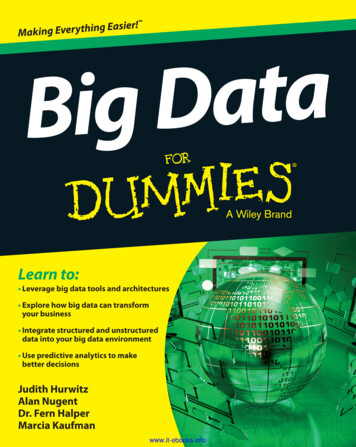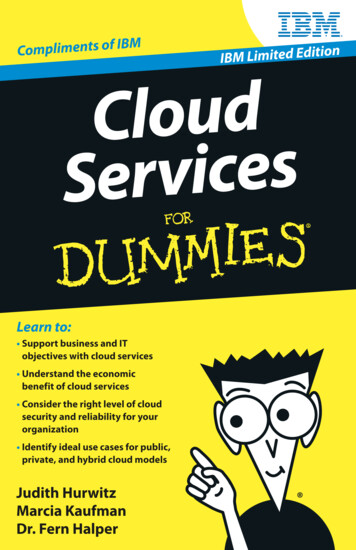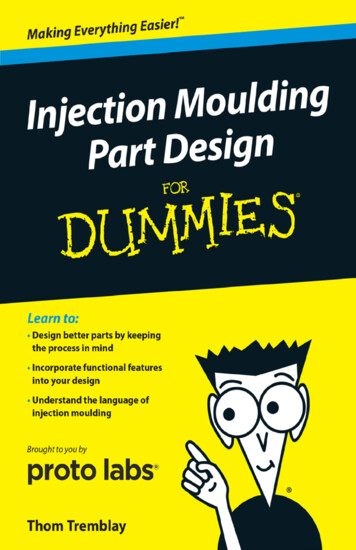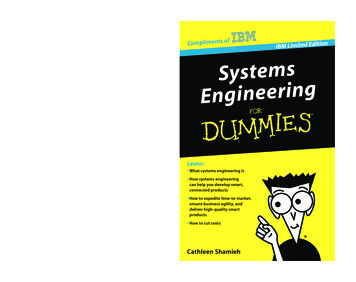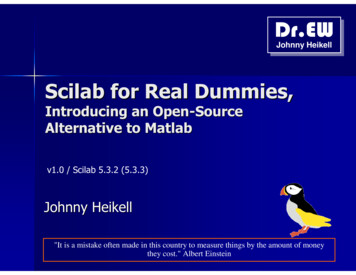
Transcription
Dr.EWDr.EWJohnnyJohnnyHeikellHeikellScilab for Real Dummies,Introducing an Open-SourceAlternative to Matlabv1.0 / Scilab 5.3.2 (5.3.3)Johnny Heikell"It is a mistake often made in this country to measure things by the amount of moneythey cost." Albert Einstein
About this presentationI compiled this presentation while familiarizing myself with Scilab forbasic engineering applications. The exercise taught that a reason to thelimited spread of Scilab is lack of good tutorials in English, which makeslearning Scilab a frustrating experience for programming newbies. It’s apity because Scilab deserves better recognition. Hopefully thispresentation can be of use to at least some Scilab aspirants.The text no doubt has shortcomings and errors. I hope to come up withan improved version in a not too distant future (with Scilab 6). Pleasepost comments & suggestions at:Espoo in August 2011Johnny Heikellwww.heikell.fiLinkedInCopyleft: This material is released under the onlycondition that you do not put restrictions or a pricetag on your redistributions—modified or not—andadd this requirement to child copies.Otherwise J. Heikell 2011
Tribute to old gods The best Scilab tutorials are non-English. The following are the onesthat I have consulted most for this work: Timo Mäkelä’s Scilab/Xcos tutorials (3 parts) in Finnish http://sites.google.com/site/tjmakela/home . Heavy on mathematical formalism,standard dull LaTeX typesetting, but the best one I know Jean-Marie Zogg’s Arbeiten mit Scilab und Scicos in German http://www.fh-htwchur.ch/uploads/media/Arbeiten mit Scilab undScicos v1 01.pdf . It’s good and informal, and contains details thatMäkelä has omitted. Needs updating Wolfgang Kubitzki’s mixed tutorials in German that can be found at http://www.mst.fh-kl.de/ kubitzki/ . Quite good, a lot of details, fewpractical examples (scripts in separate .zip files)I am indebt to their work.“To copy from one is plagiarism, to copy from many is research.” Unknown
Why I did itthe way I did it As a grad student at KU in 1990-91, I needed to quickly learn MathCADor Matlab. A fellow student showed me MathCAD basics in 15 minuteswith the use of a sine function. The lecture went something like this: “First you declare the variables that you need” “Then you define the function that you want to plot” “After that you write the plot commands”With that teaching I got started and was able to use MathCAD for myMS thesis.Lessons learned: Show examples and skip the academic trivia.I am deeply grateful to Jim for his lesson. We’ll repeat it as soon asScilab is installed and opened.
Why PowerPoint? Why do I release this tutorial as a PowerPoint* presentation when thereis enough material for a 400-page book? There are several reasons:1.2.3.4.5.6.These were originally personal notes, I recognized only later thatthey may be of use to othersIt is easy to edit PPT material slide by slideYou get a quick overview of the discussion at hand by shiftingbetween PPT’s Normal and Slide Sorter viewsPPT has an advantage over PDF in allowing the reader to modifythe work the way (s)he likesYou can copy-paste the provided scripts into Scilab’s Editorwithout having to rewrite them, only minor editing is neededAnd finally, I have seen too many depressing LaTeX documents*) .ppt documents do not require MS software. LibreOffice works as well (atleast up to PPT 2003) but some editing may be needed. Oracle threw in thetowel on OpenOffice in April 2011, but it lives on in the Apache Incubator.
Why simulate? British physicist and engineer Lord Kelvin(William Thomson) is known to have said:“When you can measure what youare speaking about and express it innumbers, you know something aboutit.” His words can be paraphrased in computerage terms:“When you can simulate what you arespeaking about and present it visually,you know something about it.”Lord Kelvin 1827-1904
Contents1.2.3.4.5.6.7.8.9.10.IntroductionA first peek at ScilabThe Console & EditorExamples, Set 1Matrices, functions &operatorsExamples, Set 2Graphics & plottingExamples, Set 3Converting Matlab filesSubroutines11.12.13.14.15.16.17.18.19.20.Flow controlExamples, Set 4Doing math on ScilabExamples, Set 5Working with GUIsFile handlingAnimationMiscellaneousExamples, Set 6AdieuHOW TO HYPERLINK IN POWERPOINT: 1) Slide Show mode: Byclicking on the underlined text. 2) Norman View mode: Put cursor on theunderlined text right-click Click: Open Hyperlink. (There is a bug inPowerPoint, hyperlinking to certain slides is impossible, e.g. to Chapter 19.)
Dr.EWDr.EWJohnnyJohnnyHeikellHeikell1. IntroductionWhat is and why use Scilab?Return to Contents
What Scilab is (1/2) A software package for scientific and engineering computing,quite similar to MatlabScilab is a tool for numeric computing, as are Excel, GNUOctave, Matlab, etc. The alternative is symbolic computing, towhich belong Maple, MathCad, Mathematica, and othersDeveloped by Consortium Scilab (DIGITEO), behind which area number of French institutions and companiesIncluded in the Scilab package is Xcos, a graphic modelingand simulation tool. However, it is not compatible withSimulink. Xcos 1.0 came with Scilab 5.2, before there wasScicos. The confusion is complete with a rival called ScicoslabScilab is free and can be downloaded at www.scilab.org
What Scilab is (2/2) Scilab is matrix-oriented, just like MatlabIt allows matrix manipulations, 2D/3D plotting, animation, etc.It is an open programming environment that allows users tocreate their own functions and librariesIts editor has a built-in, though elementary, debuggerMain components of Scilab are:––– An interpreterLibraries of functions (procedures, macros)Interfaces for Fortran, Tcl/Tk, C, C , Java, Modelica, andLabVIEW—but not for Python and/or RubyWhich is “better,” Matlab or Scilab?– Matlab outperforms Scilab in many respects, but Scilab iscatching up. The use of Matlab is motivated only in specialcircumstances due to its high cost
Why use Scilab—personalreasons Matlab 6.5 (R13) was not compatible with my new Windows Vistalaptop. MatWorks, Inc., recommended to buy a new versionI refused to pay another license fee for Matlab and went looking foropen-source alternatives:–––Sage felt bulky, immature, and focused on pure mathematicsPython is not optimized for scientific and engineering tasksPython(x,y) messed up my PC when I installed it. Maybe I should Ihave tried SciPy instead?– I grew tired of GNU Octave before I figured out how to downloadand install it (I want a tool to use, not to fight against)– Scilab was the fifth alternative that I looked at. It gave no immediateproblems, so I stuck to it. Later I have come across bugs andcrashes/lockups—and become frustrated with its poor documentationWould I still select Scilab? Yes, I am impressed by Scilab and believe that thecompetitors cause you gray hair as well—one way or another.
Why people don’t useScilabThe following are some comments about Scilab and open-sourcesoftware in general that I have come across: “Scilab? Never heard of it” “Octave is closer to Matlab” “As a company we have to use software that will be supported tenyears from now” “It doesn’t have the toolboxes that we need” “There is a cost involved in shifting to a new software tool, even ifthe tool is gratis” “Training and documentation support is poor” “There are no interfaces for other software tools that we use” “It seems to be rather slow”Conclusion: Scilab, like other open-source programs, lacks credibilityin the eyes of users—particularly professional users. The situation issimilar with various excellent Linux distros and the LibreOffice officepackage. Users trust products that have to be paid for
Scilab advantages Numeric computing is better suited for complex tasks than symboliccomputingNot all mathematical problems have closed form solutions, numericcomputing will therefore always be neededScilab is similar to Matlab and keeps developing even closer. It isquite easy to step from one to the otherScilab requires less disk space than Matlab and GNU OctaveIt includes a Matlab-to-Scilab translator (.m files to .sci files)Data plotting is said to be simpler than with GNU Octave (but thetrend is toward more complex handle structures)The Xcos toolbox installs automatically with Scilab, be it, that Xcos isnot compatible with SimulinkScilab installs without immediate problems on Windows computersScilab is free—if your wasted time and frustrations are worthnothing. The fight for a limited number of expensive licenses(Matlab, Mathematica, etc.) is not an issue in professional life
Scilab disadvantages Numeric computing introduces rounding errors, contrary to symboliccomputingThe learning effort required by numeric computing is higher than forsymbolic computingScilab lacks a unified tutorial and/or user’s manual. You “try and cry”and waste time searching for information on its use*In some cases Scilab executes much slower than Matlab and GNUOctave (improvements are said to be under way)Scilab’s tools for creating GUIs are poor compared with MatlabThe Help Browser is very formal and of little use to newbiesScilab has bugs and tends to crash/lockup (it happens to Bill Gatesas well. Often)On-line support from Equalis costs 495 or more per annum (theFrench prefer to )*) Scilab is not alone. The open-source community has a poor track record indocumentation because “paperwork” does not bring recognition.
Terminology: “function”The C programming language brought confusion with itsunrestricted use of the term “function” and this is repeated inScilab. The term refers to (at least): Mathematical functions in general Scilab’s built-in functions User defined functions (UDF) I would prefer the terms function, macro (or procedure), andsubroutine respectively (protests form dogmatic programmers areoverruled). Sometimes I talk about subroutine, but it is not alwayspossible. For instance, function is the term that must be used todefine a UDF in Scilab. And there is also the risk of adding to thebewilderment by applying own terminology. The confusionremains.
Intro to problems (1/3):crashes & lockupsProcessor loads of thismagnitude are normal duringcomputer startup. However, thisis the situation after Scilab hadcrashed and I had closed it.“WScilex.exe” had another of itslockups and required to beclosed with the Task Manager(or by rebooting the computer).The Scilab team’s standardanswer to problems like this isto make sure that thecomputer’s drivers are up-todate. It has not worked for myWindows Vista PC.
Intro to problems (2/3):new releases* With Scilab 5.2 came a problem that I did not experience withversion 5.1.1: Copy-pasting from Scilab’s Editor to PowerPointfrequently caused the latter to crash. The bug has been fixedWith Scilab 5.3.0 I found that the paths File/Open file in. andFile/Save file in. on the Editor were unresponsiveSome scripts that I originally wrote using Scilab 5.1.1 did not workwith Scilab 5.3.0, and GUIs on 5.3.2 are a real pain down thereTypically larger updates come with bugs and are quickly followed byminor “bug fix” updates (a.k.a. patches). Scilab 5.3.1 emerged withinthree months of 5.3.0. This is universal in the software businessIt is wise to keep an old Scilab version until you know that the newrelease can be trusted (I was happy I had kept version 5.1.1 whenGUIs on 5.3.1 & 5.3.2 gave me problems)*) Various Scilab versions are mentioned. I have worked with Scilab 5.1.1 5.3.2. Scilab 5.3.3 came too late to be considered.
Intro to problems (3/3):ATOMS and nerds ATOMS is Scilab’s system fordownloading and installing userdeveloped toolboxes. It has given mereal gray hair I installed two toolboxes and Scilab plotsbecame a mess. Here you can see whatthe later discussed rotation surfacelooked like with toolboxes installed I found what caused it after reinstallingWindows and the toolboxes. It took medays to get all programs running The idea of user contributions is basicallysound, but there is a risk with nerds thathave more zeal than ability and tenacityto properly test their programs
Embedded information Scilab comes with some built-in information structures. The majorones are:– The Help Browser that can be accessed from various windows. Its utilityimproved with Scilab 5.3.1 when demonstrations were included, but theHelp Browser is still a hard nut for newbies. It confuses by sometimesreferring to obsolete functions– Demonstrations that can be accessed from the Console. Not reallytutorials and some of them act funny, some may cause Scilab to crash,and others still ask for a C compiler– Error messages displayed on the Console. Quite basic messages,sometimes confusing, sometimes too brief What is really missing is an embedded tutorial (or even a user’smanual of the Matlab style) that is updated with each Scilab release
Information on the Web(1/2) The main portal is Wiki Scilab, http://wiki.scilab.org/Tutorials ,were most of the accessible tutorials are listedScilab’s forge http://forge.scilab.org/ is a repository of “work inprogress,” many of which exist only in name. Its set of draftdocuments is valuableWiki Scilab’s HowTo page http://wiki.scilab.org/howto has somearticles of interestFree sites:– Scilab File Exchange website http://fileexchange.scilab.org/ . A newdiscussion forum managed by the Scilab team and “dedicated to easilyexchange files, script, data, experiences, etc.”– Google discussion group at scilab/topics – MathKB http://www.mathkb.com/ . Contains, among other things, aScilab discussion forum. Mostly advanced questions– spoken-tutorial http://spoken-tutorial.org/Study Plans Scilab/ .Screencasts under construction by IIT Bombay. Scilab basics
Information on the Web(2/2)– YouTube has some video clips on Scilab, but nothing really valuable– Equalis http://www.equalis.com . By registering you gain free accessto the discussion forum– http://usingscilab.blogspot.com/ used to be a very good blog but isnow terminally ill. Worth checking the material that is still there– Scilab India http://scilab.in/ is basically a mirror of Scilab Wiki, withadded obsolete material and a less active discussion forum If you know German:– German technical colleges produce helpful basic tutorials on Scilab(better than their French counterparts). Search the Internet e.g. usingthe terms “Scilab” “Einführung” and limit the language option toGermanConclusion: A lot of resources have gone into producing the existingscattered documentation, but they have been uncoordinated andhave produced little relative the input effort. Lousy management!
Books There is not a single good textbook in English on Scilab like you find inabundance on Matlab. These are the books that I am familiar with: Beater, P.: Regelungstechnik und Simulationstechnik mit Scilab undModelica, Books on Demand GmbH, 2010. Basic control systems formechanical engineers. Scilab plays only a minor role in the book Das, V.V.: Programming in Scilab 4.1, New Age International, 2008.Reference manual with uninviting layout, obsolete functions, and nopractical examples. Useless Chancelier, J.-P. et al.: Introduction á Scilab, Deuxième édition, Springer,2007. An intermediate/advanced textbook with some engineeringapplications. Approaching obsolescence Campbell, S.L. et al: Modeling and Simulation in Scilab/Scicos, Springer,2006. Based on Scilab 3.1, over half of the book is on Scicos. Of someuse, but dull the way Springer and LaTeX make them Gomez, C. et al.: Engineering and Scientific Computing with Scilab,Birkhäuser, 1999. Often referred to but outdated and of no use
On updates & literatureScilab evolves rapidly and one frequently encounters obsoletefeatures. Functions are often declared obsolete, although Scilab stillmay support them, and other functions are removed altogether.There is obviously no collection of obsolete/removed functions andtheir current equivalents (if any).The Scilab team is slow with information on major updates. Forinstance, the GUI interface is said to have been completely renewedwith version 5.x, but so far the only (poor) GUI description that Ihave seen is for version 4.x. It’s almost three years now.Rapid development is a reason to why the limited literature on Scilabis mostly obsolete, sometimes outright misleading. I got a hands-onexperience with all the changes that had to be made to 5.1.1 scriptsbefore they agreed to run on version 5.3.x (and not all do)
Scilab learning obstaclesLearning Scilab can be frustrating to a person with limited previousprogramming experience. The biggest hurdles are: Lack of hands-on tutorials for English-speaking newbies. Thesituation is better, though not good, with some other languagesExcessive number of Scilab functions. There are some two thousandof them. There are often numerous options to select between; someof which work, some don’t, some of which you know, most you don’tUnhelpful Help Browser. Even when you have a hunch of whichfunction to use, you cannot get it right because of the Help Browser’scryptic explanationBasic programming errors. Creating infinite loops, dividing by zero,using * instead of .* , etc. We all make them, there is no wayaround them than by practicing. “Übung macht den Meister!”
On the bright side. Scilab works! Despite my complaints it mainly does a fine jobIt is a great thing that it is given away for free to all of us whocannot afford expensive commercial simulation toolsIt is a great thing that it is give away for free to all commercial andnon-commercial institutions that care about cost-effectivenessIt is a free gift (though with restrictions*) to science and engineeringand deserves support of us who happily download whatever comesgratis on the WebIt deserves support because Scilab, like other open-source ITsolutions, faces an uphill struggle against vast commercial interestsand skeptical individualsLong live the free and open-source/access community!*) Scilab is released under the French CeCILL license. The question is, is itreally a Free and Open-Source license that allows you to release a Scilab copyunder a new name, the way OpenOffice was turned into LibreOffice?
Dr.EWDr.EWJohnnyJohnnyHeikellHeikell2. A first peek at ScilabWhat you face when trying to getstarted—including “Scilab in 15minutes”Return to Contents
Windows installation (1/3)1. Download Scilab fromwww.scilab.org(Windows on the top,other OSs below)2. The right operating systemshould be on top. Save the file,typically it goes to your ownDownloads folder
Windows installation (2/3)3. Scan the downloadedfile for virusesInside theDownloads file4. Double-click on thefile to install Scilab,follow the prompts
Windows installation (3/3)5. Scilab suggests that itshould install alltoolboxes (modules). Gofor it unless you arereally short of memory6. Accept Scilab licenseterms (you have nooption so why do theyask?). Click Next asmany times as needed7. You’re all set to useScilab (no need toreboot the computer)Note: Scilab does notuninstall an old version
Linux installationThis discussion is valid for Ubuntu10.04 LTS with the GNOMEdesktop* Click: Applications/UbuntuSoftware Center/Science &Engineering and scroll down toScilab; then just Click Install Only Scilab 5.3.0 beta-2 isavailable at the repository For the latest version you mustgo to Scilab's web site anddownload Linux binaries. Theinstallation, however, is atrickier question and I do notcover it here (have not tried it)*) Ubuntu 11.04 with Unity has beenreleased, but I have not gone for it
The ConsoleClick on Scilab’s shortcuticon to open the Console(Command Window inMatlab*):Menu barToolbarCommand promptIf no shortcut icon has beencreated: Click: Start\AllPrograms\scilab\scilab (donot select Scilab Console)*) The Console has other names as well: Workspace, Startup/Main Window, etc.
Folks:Here it comes, the lesson onMathCad that Jim gave me back in1991, transformed to Scilab. Alecture worth gold in three slides
Scilab in 15 minutes(1/3): write a scriptRecall how Jim taught me MathCAD in 15 minutes? Now we’ll repeatthat lesson in Scilab. We do it by using the Editor (SciNotes):Step 1: On the Console, Clickthe leftmost icon on thetoolbar. The Editor pops upStep 2: Define whatevervariables your function needs(row 1). Note comment (// )Step 3: Next, define the (sine)function in case (row 2)Step 4: Finally, write theplot command (row 3)
Scilab in 15 minutes(2/3): save and plotStep 5: Save the script byClicking on the Save iconand name it e.g. foo.sceStep 6: Finish by running(executing) the script by aClick the Execute icon (asecond one came with 5.3.2)Step 7: Up pops theGraphics Window with the aplot of the defined equationDid you have problems or get anerror message on the Console? Don’tworry, we’ll return to everythinglater. Jump to Examples 1-1 & 1-2 ifyou are in a hurry.
Scilab in 15 minutes(3/3): discussionThis exercise showed the essentials of Scilab in engineeringapplications: Scilab’s user interface consists of three main windows:– The Console, which pops up when Scilab is opened and on whichit outputs textual data (numeric answers, error messages, etc.)– The Editor (SciNotes), which is the main tool for writing, saving,and executing scripts (programs)– The Graphics Window, on which Scilab presents plots The recipe for using Scilab is the one that Jim taught me:– First you declare the variables that are needed– Then you define the function that you want to plot– And finally, plug in the plot instruction That was ScilabLet’s go pizza
The Console’s menu bar(1/6): FileAmong the functions under theFile drop-down menu that youwill quickly encounter are:Execute.: From here you canrun Scilab scripts (or from theEditor, as seen later)Open : Similar to the Open command in MS OfficeprogramsChange current directory ,Display current directory:Pay attention to those two, theywill be needed to tell Scilabwhere to look for a script thatyou want to open
The Console’s menu bar(2/6): EditThe functions under the Edit dropdown menu are self-explanatory.The Cut, Copy, and Pastecommands have their own icons inthe toolbar. You also find them byright-clicking on the PC mouseBe careful with Empty clipboard.You may not be able to use Copyafter clicking it! (Happened to me)I have used Select all a lot tocopy-paste the demos in thispresentation
The Console’s menu bar(3/6): PreferencesThe functions under thePreferences drop-down menuare quite similar to what youcan find on a PCI can only guess that ClearHistory is similar to ClearPrivate Data in Firefox, butthere is no Show Historyalternative and Help is nothelpfulClear Console empties theconsole. You achieve the sameby pressing F2Change visual appearanceof the Console
The Console’s menu bar(4/6): ControlI did not need the Controldrop-down menu a single timewhile doing this presentation,so obviously it is not veryusefulMy guess would be that theResume , Abort, and Interruptalternatives give the user away to interfere with theexecution of a programThe Help Browser is notvery helpful and it doesnot even recognize theInterrupt command
The Console’s menu bar(5/6): ApplicationsSciNotes: Opens Scilab’s TextEditor (same as LaunchSciNotes in the toolbar)Xcos: Opens XcosMatlab to Scilab translator:Used to translate a Matlab .mfile to a Scilab .sci fileAtoms: Opens the onlinemodule managerVariable Browser: Opens a listwith variables (same as thebrowsevar; command)Command History: Opens a listwith commands used
The Console’s menu bar(6/6): Help alternativesScilab Help: Same as thequestion mark icon in thetoolbarScilab WebresourcesScilab Demonstrations: Showsdemos with few comments (same command asthe cogwheel in the toolbar). At least theGUI/Uicontrols 2 demo causes Scilab to crash
The Console’s toolbarThe Atoms, Xcos, and Demonstrationsicons came with Scilab 5.2Launch Editor: Opens Scilab’sEditor (SciNotes, another partof its Integrated DevelopmentEnvironment (IDE). Basictutorials seldom stress the factthat normally we work with(write, edit, save, run)executable Scilab scripts on theEditor, not on the Console. TheEditor is presented a few slidesbelowChange Current Directory: Itcan also be found under Filein the menu bar. You need it topoint out from which directory(folder) Scilab should searchfor a script that you want toexecute (run)
The Help Browser (1/3)In the Console, Click onthe Help Browser iconto open itHelp discussions becomemore readable if you printthem as PDF filesThe Help Browser is abrief “encyclopedia” ofScilab’s main features andfunctions. Explanations offunctions are augmentedby examples (see nextslide for a demo), but thisdoes not compensate fora good tutorial
The Help Browser (2/3)2. The GraphicsWindow with the plotpops up (in this cases itbriefly flashes the firstplot)1. In the script box withexamples, Click on theExecute icon to see how thescripts executes (not all work)3. Click on the Editor iconand the script is transferredto Scilab’s text Editor whereyou can play with it (must besaved before it can be run)
The Help Browser (3/3):help function nameTo find the proper useof any function—assuming that thename is known—theHelp Browser can beopened from theConsole by enteringthe command helpfunction namecommand, in theshown case helpdet() (the bracketscan be omitted). Thealternative is to openthe Browser with theHelp icon
The Editor (SciNotes) The (Text) Editor is whereexecutable Scilab scripts arewritten, maintained & runOpen the Editor by clickingon the Launch SciNotes iconin the Console, or by clicking:Applications\SciNotesA Scilab script is a text filewith a name of the type*.sce (the alternative*.sci is also used but*.sce is the default)It is good practice to usescripts also for small tasks.Then all “projects” are savedand commented, ready forreuseSave & executeExecuteBut don’t forget to create aproperly organized archivefor your programs!
Editor menu bar (1/5):FileFile commands that you are mostlikely to run into: Recent files gives quick access torecently edited scriptsNew opens a second tab for anew script to be editedOpen opens a saved script intothe EditorOpen file in. and Save file in.do not work in Scilab 5.3Print is an ordinary printcommandClose closes the file in case
Editor menu bar (2/5):EditCommands under Edit aremostly self-explanatory. Notehowever the following four:Shift Right/Left:Indent/unindent a row by onestep (this pair should be on thetoolbar)Comment/Uncomment Selection:Add/delete a comment
Editor menu bar (3/5):PreferencesThe Preferences drop-downmenu allows you adjust Editorsettings to your likingI had difficulties reading scriptson the Editor (poor contrastwith default settings) and usedSet Colors. and Set Font tochange from default values
Editor menu bar (4/5):Preferences, commentUsers can send bug reports to Scilab’s development team (link at www.scilab.org ). I filed the following report (Bug 8802):“Default color settings on the Editor produce poor contrast . Changingfont colors is tedious due to the excessive number of options underPreferences\Set colors. (an overkill, you could say). I would suggestdefault settings with just four colors (red, green, blue and black). ”To which I got this answer:“You can modify more easily the colors configuration in modifying thefile: C:\Documents and Settings\Johnny\Application Data\Scilab\scilab-5.3\scinotesConfiguration.xml (or a path which is similar) ”I found scinotesConfiguration.xml under C:\Program Files\scilab-5.3\modules\scinotes\etc\. XML color codes must bechanged in this file. I wish you good luck
Editor menu bar (5/5):ExecuteThe Execute drop-downwindow contains three options:. file with no echo: Asimple execute command(same as clicking the Executeicon on the toolbar). file with echo: Executesthe script and echoes it (showsit) on the Console. until the caret, withecho: Beats me, what it meansThe Execute commands usedto be simpler. I have no ideawhy they changed them thisway. My recommendation isto use the Execute icon onthe toolbar (see next slide)
Editor toolbarNew. Opens a secondtab for a new script tobe edited (the samecommand can be foundunder File)The Save icon looks like theDutch tricolor, but you’ll getused to it. The next one isSave as.The Undo/Redo arrowsare quite normalThe Paste icon is abit unusual (French?)The Execute (orSave & execute)icon is what younormally use to runa script
Ready to goConsole (command window)Your desktopshould now looksomething likethe one here. Aswe have seen,both the Editorand the Consoleare needed sincewhen thescripts—createdon the Editor—are executednumeric outputsis returned to theConsoleEditor (SciNotes)
One more thing (1/2):docking windows It is possible to dock Scilab windows; i.e., to form a unifiedworkspace similar to the one in Matlab. Here is how to do it:leosnoCPress the leftmouse buttonon thedarkened bar ofan activewindow, dragover anotherwindow andrelease. Thenext pageshows one caseEditor
One more thing (2/2):docking windowsleosnoCersworHelp BEditorowdniWscihpaGrEachwindowpart has anarrow inthe upperright-handcorner, bywhich youcan releaseit fromdocking
On scripts and functions Scilab has two command types:– Scripts. A set of commands used to automate computing. Scriptcommands are normally returned to the Console, but plots arereturned to the Graphics Window– Functions (macros). Short programs that interface with theenvironment through input and output variables. A list ofcommon built-in functions is given on the next slide. Functionsdefined by the user can either be local (integrated in a script) orglobal (stored as a separate file and accessible to any script)– I may use the term “code” to make general references to eitherscripts or functions As was already said—and wil
Scilab for Real Dummies, Introducing an Open -Source Alternative to Matlab Johnny Heikell v1.0 / Scilab 5.3.2 (5.3.3) "It is a mistake often made in this country to measure
